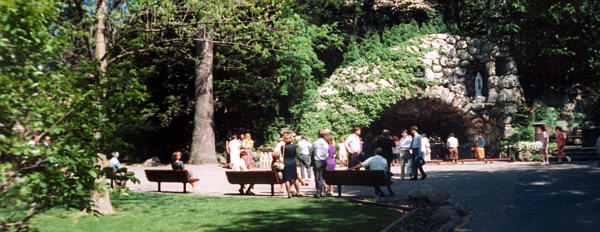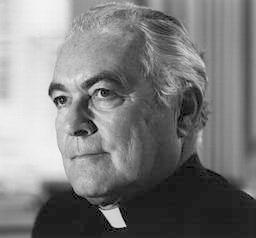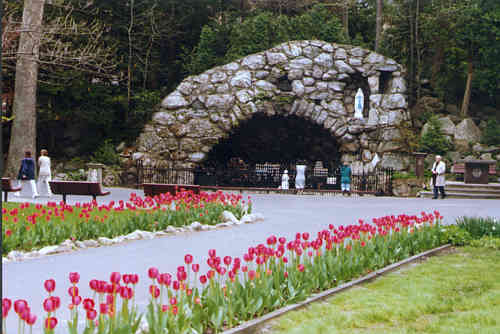
Notre Dame's Grotto / by Dorothy V. Corson


The Nightly Rosary
In 1981, Father Joseph Champlin, spoke of returning to his alma mater and the two days he spent at a conference on "that magnificently beautiful campus." He tells of the morning he walked over to the Grotto:
There I prayed the rosary, recalled moments decades earlier, watched persons stop for a visit and wondered how many million, not thousands, had paused for a similar plea to our Lady since the shrine's erection at the turn of this century.
The stone vault of the cave was blackened from the smoke of past and present votive candles -- over 1,000 were flickering on the morning of my stay at the shrine. A single flower here, a bouquet there speak silently about individual testimonies of affection for our Lady.
Nor is devotion to God's mother at the Grotto merely a carry over from the past with no appeal for the young. During my 7:30 a.m. visit a great cross-section of people passed by and paused for prayer. They included a retired Holy Cross religious brother, workmen in overalls, well dressed secretaries, professors with briefcases and several University girls who after their jog around the two small lakes knelt for a long period of time before our Lady. The last visitors symbolized for me the other 8,000 students at Notre Dame of whom many, probably most, and perhaps all have regularly or occasionally honored Mary by their presence at the Grotto.
He also mentioned "the handsome marble lectern and altar at one side of the cave and the sign reminding visitors that rosary devotions are conducted every night at 6:45."(253)
It was Father Tom McDonagh who started the rosary at the Grotto, nobody remembers when. He conducted the rosary there twice a year in May and October for a number of years. Nor does anyone remember when Brother John Lavelle started the 6:45 nightly rosary. However, Father Champlin's article indicates that it was a practice in 1981 and probably even before that time.
Father Edward O'Connor conducts the nightly 6:45 rosary currently, and has for a number of years.

When Father Hesburgh retired in 1987 students planted a tree for him at one of his favorite places on campus, the Grotto. A tree for Father Joyce is also there along with several other trees on the Grotto lawn given as memorial gifts. This practice started in the late 1970s or early 1980s. Father Hesburgh's tree was given "with upmost admiration" by the Class of 1990. A distinctive tree for a man of distinction. Like the legendary sycamore on the Grotto lawn, it has an unusual shape and name. Because of its unique, contorted, corkscrew branches, it has been dubbed the "Harry Lauder Walking Stick Tree". It was named after a well known actor who died in 1950. He always performed on stage carrying a crooked walking stick. His Memorial Tree is pictured on the right side of the path in the photograph at the beginning of this chapter.
Memorial gifts have also been given for the permanent redwood benches placed throughout the campus. The benches began appearing in the 1990s, during preparations for the 1992 Sesquicentennial. The plaques mounted on the benches at the Grotto represent memorial gifts given in memory of loved ones who had a special fondness for the Grotto and its peaceful setting.
